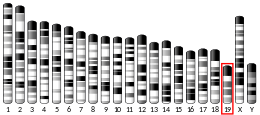ZFP91
Zinc finger protein 91 homolog is a protein that in humans is encoded by the ZFP91 gene.[5][6]
The protein encoded by this gene is a member of the zinc finger family of proteins. The gene product contains C2H2 type domains, which are the classical zinc finger domains found in numerous nucleic acid-binding proteins. In addition to the monocistronic transcript originating from this locus, a co-transcribed variant composed of ZFP91 and CNTF sequence has been identified. The monocistronic and co-transcribed variants encode distinct isoforms. The co-transcription of ZFP91 and CNTF has also been observed in mouse.[6]
References
- 1 2 3 GRCh38: Ensembl release 89: ENSG00000186660 - Ensembl, May 2017
- 1 2 3 GRCm38: Ensembl release 89: ENSMUSG00000024695 - Ensembl, May 2017
- ↑ "Human PubMed Reference:".
- ↑ "Mouse PubMed Reference:".
- ↑ Unoki M, Okutsu J, Nakamura Y (May 2003). "Identification of a novel human gene, ZFP91, involved in acute myelogenous leukemia". Int J Oncol. 22 (6): 1217–23. PMID 12738986. doi:10.3892/ijo.22.6.1217.
- 1 2 "Entrez Gene: ZFP91 zinc finger protein 91 homolog (mouse)".
Further reading
- Iuchi S (2001). "Three classes of C2H2 zinc finger proteins.". Cell. Mol. Life Sci. 58 (4): 625–35. PMID 11361095. doi:10.1007/PL00000885.
- Grottke C, Mantwill K, Dietel M, et al. (2000). "Identification of differentially expressed genes in human melanoma cells with acquired resistance to various antineoplastic drugs.". Int. J. Cancer. 88 (4): 535–46. PMID 11058868. doi:10.1002/1097-0215(20001115)88:4<535::AID-IJC4>3.0.CO;2-V.
- Yu Y, Zhang C, Zhou G, et al. (2001). "Gene Expression Profiling in Human Fetal Liver and Identification of Tissue- and Developmental-Stage-Specific Genes through Compiled Expression Profiles and Efficient Cloning of Full-Length cDNAs". Genome Res. 11 (8): 1392–403. PMC 311073
 . PMID 11483580. doi:10.1101/gr.175501.
. PMID 11483580. doi:10.1101/gr.175501. - Strausberg RL, Feingold EA, Grouse LH, et al. (2003). "Generation and initial analysis of more than 15,000 full-length human and mouse cDNA sequences". Proc. Natl. Acad. Sci. U.S.A. 99 (26): 16899–903. PMC 139241
 . PMID 12477932. doi:10.1073/pnas.242603899.
. PMID 12477932. doi:10.1073/pnas.242603899. - Obuse C, Yang H, Nozaki N, et al. (2004). "Proteomics analysis of the centromere complex from HeLa interphase cells: UV-damaged DNA binding protein 1 (DDB-1) is a component of the CEN-complex, while BMI-1 is transiently co-localized with the centromeric region in interphase". Genes Cells. 9 (2): 105–20. PMID 15009096. doi:10.1111/j.1365-2443.2004.00705.x.
- Beausoleil SA, Jedrychowski M, Schwartz D, et al. (2004). "Large-scale characterization of HeLa cell nuclear phosphoproteins". Proc. Natl. Acad. Sci. U.S.A. 101 (33): 12130–5. PMC 514446
 . PMID 15302935. doi:10.1073/pnas.0404720101.
. PMID 15302935. doi:10.1073/pnas.0404720101. - Gerhard DS, Wagner L, Feingold EA, et al. (2004). "The Status, Quality, and Expansion of the NIH Full-Length cDNA Project: The Mammalian Gene Collection (MGC)". Genome Res. 14 (10B): 2121–7. PMC 528928
 . PMID 15489334. doi:10.1101/gr.2596504.
. PMID 15489334. doi:10.1101/gr.2596504. - Tompkins V, Hagen J, Zediak VP, Quelle DE (2006). "Identification of novel ARF binding proteins by two-hybrid screening". Cell Cycle. 5 (6): 641–6. PMID 16582619. doi:10.4161/cc.5.6.2560.
- Olsen JV, Blagoev B, Gnad F, et al. (2006). "Global, in vivo, and site-specific phosphorylation dynamics in signaling networks". Cell. 127 (3): 635–48. PMID 17081983. doi:10.1016/j.cell.2006.09.026.
This article is issued from
Wikipedia.
The text is licensed under Creative Commons - Attribution - Sharealike.
Additional terms may apply for the media files.




